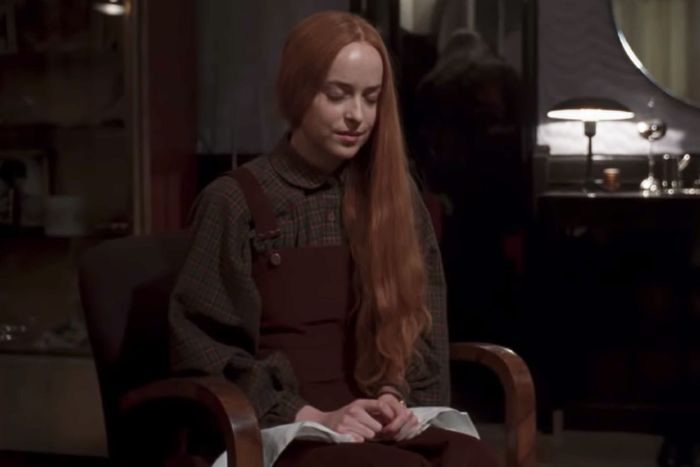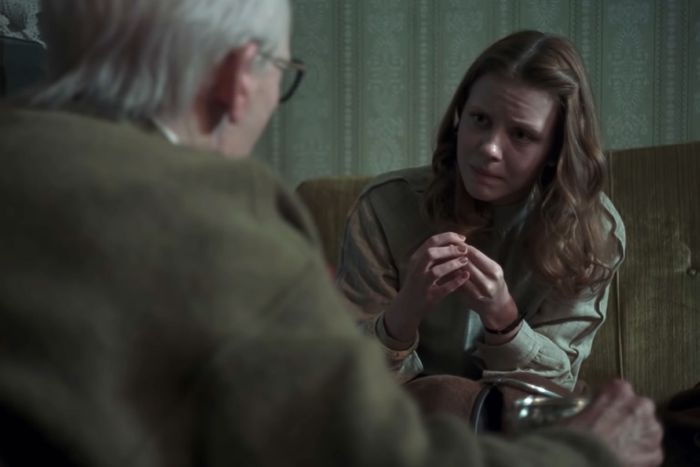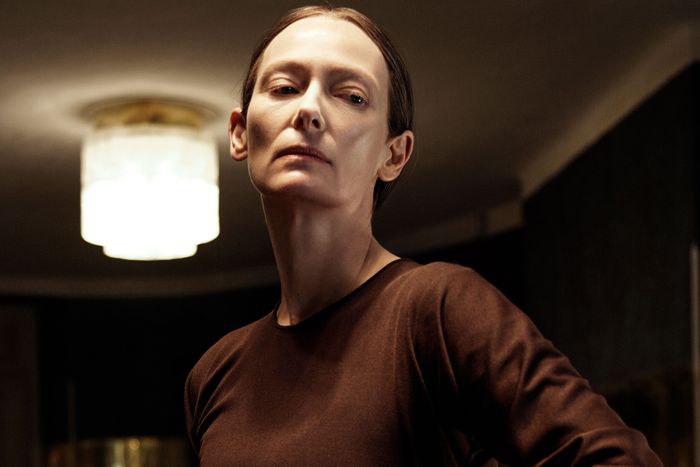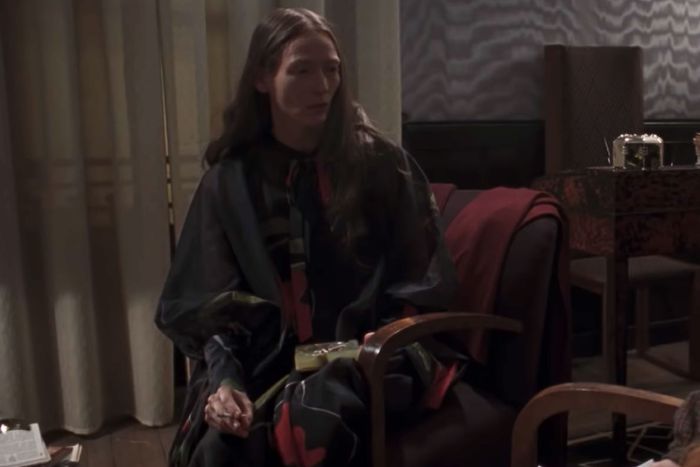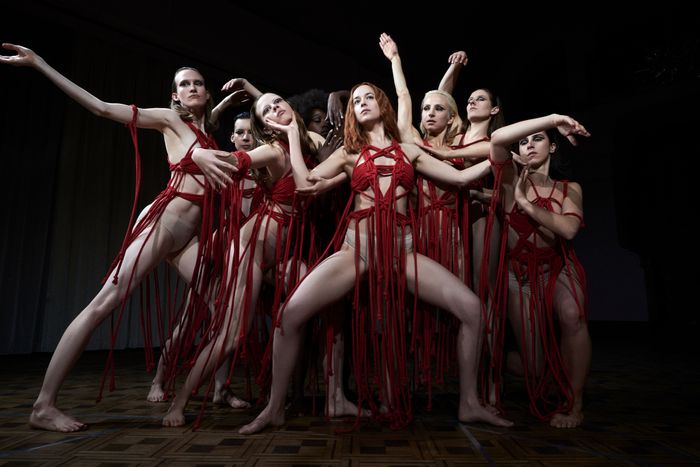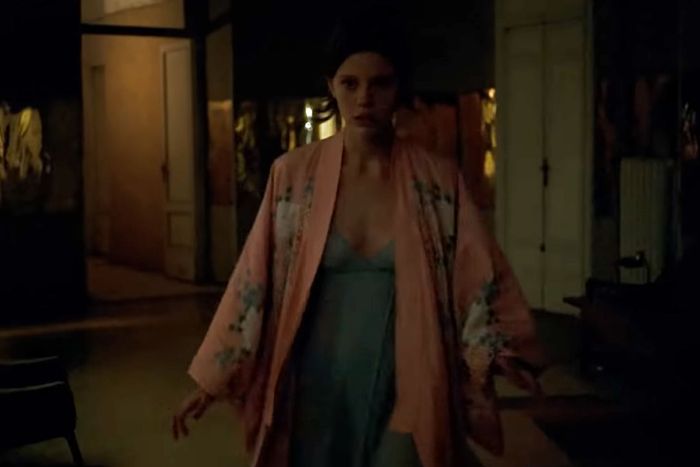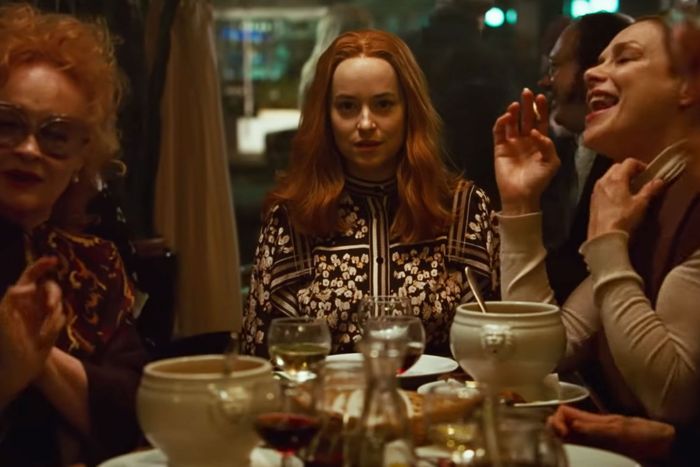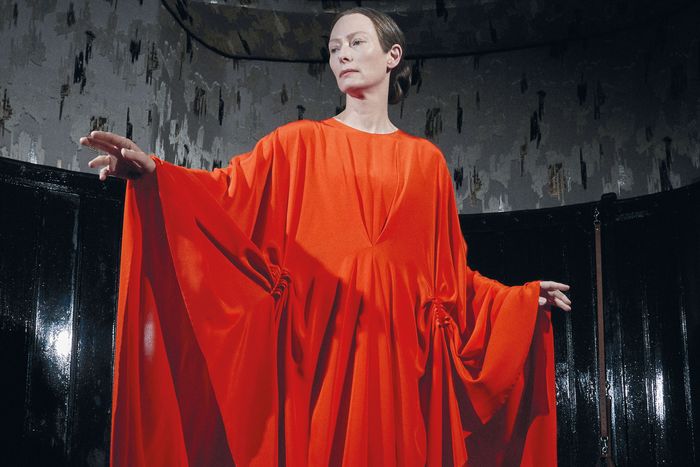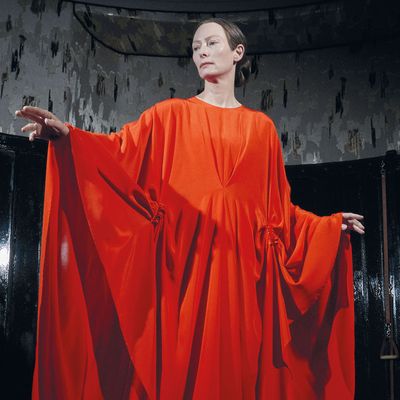
If you’re a film lover with a soft constitution, there are a few scenes of virtuoso violence in Luca Guadagnino’s Suspiria that might warn you off the picture entirely. But we encourage you to at least try and gut out (pun definitely intended!) this 2018 remake of Dario Argento’s signature film from 1977, because not only is it a timely, provocative horror picture about an entirely feminine micro-society that revolves around dance and witchcraft, it’s also about 150 minutes of straight-up clothing porn. Are ribs cracking out of place and bones bursting through skin and barrels of blood too much for you? Take a few bathroom breaks or use those opportunities to re-up your Junior Mints stash, but then settle back into your seat for inter-coven politicking and an array of 1970s period clothing that you’d sacrifice someone in a Black Sabbath to keep.
Guadagnino makes great movies, full stop, but integral to his filmmaking style is … an overabundance of style. From I Am Love to Call Me by Your Name, the characters in a Guadagnino film are all living deliciously, even if they’re frequently racked by heartbreak or, in the case of Suspiria, groomed for dark uses by extraordinarily powerful witches. Such a modus operandi means wardrobe and styling are essential to the world-building. As much as Guadagnino wants you to see and hear Suspiria, he wants you to feel it in your chest, to be immersed in the total experience of it — and that is where costume designer Giulia Piersanti comes in to cast her sartorial spells.
Piersanti has worked with Guadagnino twice before, on A Bigger Splash and CMBYN — yes, she is responsible for Armie Hammer’s instantly classic boxy button-downs and short-shorts — but the setting and the circumstances of Suspiria gave her a chance to create a more extravagant wardrobe than those previous films. “Contrary to Call Me by Your Name, in which the biggest work was what not to put on and to be very minimal, with Suspiria there was no limit,” Piersanti, a freelance designer who works with luxury brands like Céline, tells Vulture. “I was able to go all-out and bring inspiration from many of the artists and designers and historic things that inspire me and make all the bespoke pieces I wanted.” Breaking down each and every look in Suspiria could fill a mighty handsome coffee-table book, but until we can conjure that into existence, here is Piersanti on a few of the film’s key ensembles.
Susie, Fresh Off the Farm
The transformation of Susie Bannion (Dakota Johnson) can be traced through her clothes. She arrives in Berlin after traveling from the small Ohio town, where she was raised in a conservative religious community, and is visibly more homely than the other girls at the Helena Markos Dance Academy. These origin-story details are crucial for Piersanti, who likes to know the background and cultural influences of characters that she designs for. “When we first meet Susie, she is a modest and prude farm girl, a runaway from a Mennonite community,” Piersanti says. “As she evolves into her own womanhood and becomes more open and strong, her wardrobe changes.”
For Susie’s earlier looks in Suspiria — like when she snoops around the Academy’s administrative office with another dancer, or when she first arrives in Berlin — the designer says she drew specific inspiration from Diane Keaton’s character in the 1978 film Interiors. As the character grows more cosmopolitan and more confident, she starts dabbling into the much more refined wardrobe of her new friend, Sara Sims (Mia Goth).
Sara, Sneaking Around
Sara has the most enviable closet of any character in Suspiria, and actress Mia Goth wears every custom-sewn piece like she was born to be a child of refinement studying the arts in Cold War Berlin. “Sara is bourgeois and refined,” says Piersanti, who drew substantial inspiration for the character’s style from a German Democratic Republic magazine called Sybille, a culture and fashion publication that was popular at the time. “All her looks and accessories are coordinated. All the clothes I made for her are in camels, browns, and overlapped checks, and her hair is always well-done.”
Sara dons one of her most striking looks when she takes her first clandestine meeting with Tilda Swinton’s Dr. Klemperer. “She’s wearing her raw silk bourette pants with high banana-color boots and beige check shirt,” explains Piersanti, giving the silhouettes she loved in Sybille — which she has called “a socialist version of Vogue” — heavy credit for the ensemble: “She has a bit of Eyes of Laura Mars look to her.” And because Sara is maybe the best-dressed sleuth in all of Germany, she hits a peak of chic once again while poking around the matron’s office in the Academy in search of clues about the disappearance of another dancer: “The big beige check dress she wears is inspired by a picture of one of my favorite designers, Anne Marie Beretta.” Sara’s makeup and perpetually bouncy hair were based on the model and singer Bebe Buell, who was popular in the 1970s.
Madame Blanc, in the Studio
The image of Tilda Swinton in a sleek brown dress that seemed to extend her long body by another two feet was an immediately indelible image from the first Suspiria trailer. With Guadagnino endeavoring to remake one of the most colorful and aesthetically iconic horror films of all time, the prevalence of browns and grays let audiences know that this version of the film would have a visual signature all its own. Despite his tendency toward maximalism, the director and his costume designer wanted to avoid aimless flamboyance. So despite her power and position near the top of the coven’s hierarchy, the Academy’s creative director hewed to a simple and pragmatic sensibility while on the job. “I liked the idea that Madame Blanc is very disciplined and essential in her choice of wardrobe, with clothes that prioritize movement as she dances,” Piersanti says. “She does not differentiate her work clothes. Her work uniform is her style.”
Blanc’s paired-down studio look also helped to highlight the more bold fashion statements she would make at later stages in the film.
Madame Blanc, Dining Casually
There’s one perfect scene in Suspiria that consists of Susie and Blanc dining on chicken wings in the Academy director’s private residence. It’s a stilted get-to-know-you between new-student Susie, in her comparatively drab Ohio threads, and Blanc, who has shucked her sheath dress and is now lounging in a glorious caftan while lightly tearing at a chicken bone. It’s a jarring departure from her simple, utilitarian instructor’s uniform. “I wanted her to be old-school by making her the most dressed up and theatrical while in her nightgown in the privacy of her quarters,” says Piersanti. “One thing Luca asked was for Madame Blanc to be as regal as Anton Walbrook in The Red Shoes. I designed the print on her nightgown, and the big abstract tulips are actually made of red women’s body shapes with women’s face profiles.”
With the exception of few pieces, almost the entire Suspiria wardrobe was custom-made. The costume designer told Vogue that shoes for the production were designed by Francesco Russo, and much of the printed fabric was sourced from a factory that works with top-tier fashion houses like Prada and Louis Vuitton.
The Volk Costumes
As choreographer Damien Jalet told Vulture, Suspiria’s central dance number, called Volk, was modeled after a piece he had previously created called Les Médusés. The dancers in Les Médusés even wore white rope costumes that were used as a foundation for the new outfits designed by Piersanti for the film. “I was inspired by a 1970s performance by the artist Christo, who uses ropes in most of his work,” she explains, including photographer Nobuyoshi Araki as one of her reference points for the Volk look. “I also looked at bondage techniques to learn how to knot the ropes into a witchcraft star shape on the body of the dancers. We bought meters and meters of red bondage rope from sex shops. I also tied the knots around the arms and left all the ropes hanging to emphasize the sharp movements of the choreography and rhythmic music.” And you know what else those red dangling strands call to mind? Dripping blood.
That Pink Robe
One of the best single articles of clothing in all of Suspiria is a pink robe that we see first on Sara and then later on Susie. “This pink kimono is a vintage I chose for its color,” says the costume designer. “When Susie’s character changes, as she gets more sure and sophisticated, she takes her clothes from Sara to evolve her look, starting from the pink kimono.” Once tragedy befalls poor Sara, Susie’s appearance in the robe helps to signify her full transition from untrained transplant to a powerful force with the Markos Academy. It’s also just fabulous.
Susie’s Last Supper
When Susie attends the dinner party immediately following her company’s performance of Volk, she is well on her way to confronting destiny. She knows that she is going to assume her place among the coven — even if she doesn’t yet understand what that means — and she is radiating a silent confidence. Gone is the shy Ohio girl, and in her place sits a woman ready to claim her true power. And what says I’m about to take my future in my hands and literally stare death in the face more effectively than a fierce ensemble? “I designed the print on her dress, which is inspired by Louise Bourgeois drawings. They are scattered women’s hip bones made to look like cherry-tree branches.” And you thought you were just looking at a chic black dress with beautiful gold stitching! Piersanti added, “There’s a recurring theme of archetypes of the women’s body — like hair for the Sabbath dresses, arms, legs, and vaginas — reinterpreted in ’70s prints for blouses and dresses, which we made in the atelier.”
The Black Sabbath
You may have read about the hair lining the walls in the Room of the Feasts, where Suspiria’s wild Black Sabbath scene takes place, but did you notice that the coven matrons were wearing hair, too? As Piersanti told The Wall Street Journal, “The dresses are made out of real human hair extensions, and are inspired by artist Rebecca Horn’s performances and designer Martin Margiela.” Each of the haunting hair dresses was individually made and “draped in different motifs on a flexible cagelike structure made of ribbons.” Just like the hair hanging on the walls, the extensions on the dresses were meant to come from previous victims of witch sacrifices. The Sabbath scene took a week to shoot and involved buckets of blood, which had to be delicately washed and combed out of tresses at the end of each shooting day.
As for our remaining featured style icons, Blanc and Susie, their Sabbath looks also tell a story. Susie has removed her hip-bone-laden black dinner dress at this point and changed into a sheer brown kind of caftan, going from modest layers at the beginning of the film to “more open and strong” and comfortable with her naked body. Blanc, meanwhile, has saved her most extravagant look for the most special of witch occasions. “Her red dress was inspired by an old photo of a Madame Grès dress,” Piersanti says, referring to the early 20th-century couturier who founded the couture fashion house Grès. “Madame Blanc’s whole wardrobe is a reinterpretation of a T-shirt-like dress. Here, I wanted her to have her own interpretation of something ceremonial without going with the obvious capes.”



